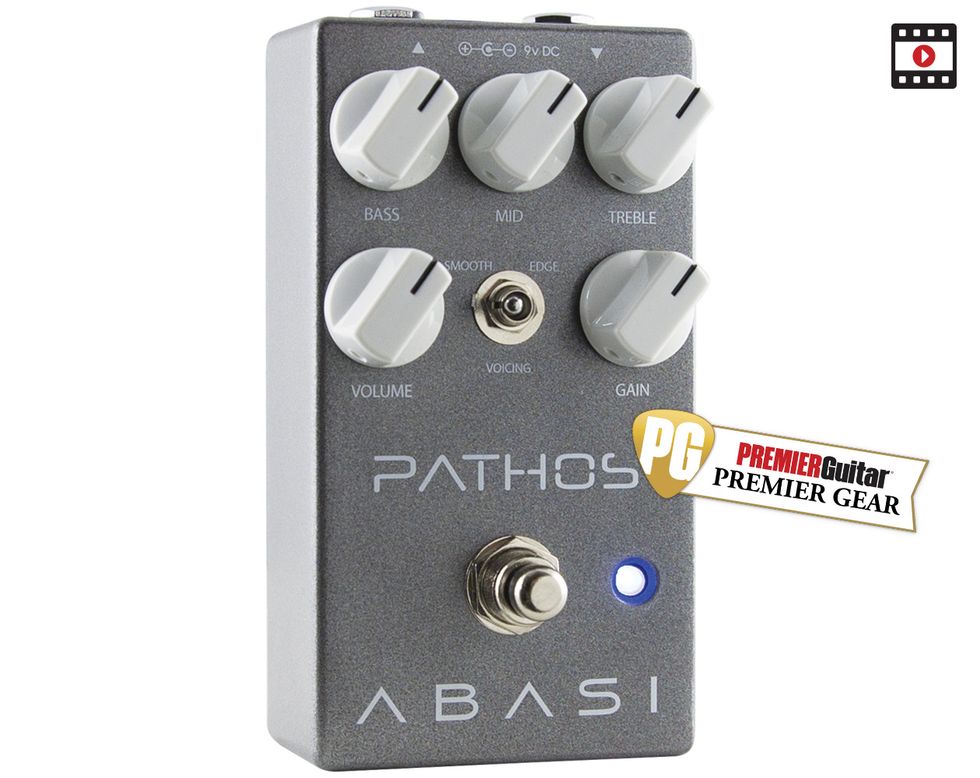RatingsPros:Excellent sounds throughout. Incredibly dynamic. Cons: Smooth and edge voicings not footswitchable. Street: $199 Abasi Concepts Pathos abasiguitars.com | Tones: Ease of Use: Build/Design: Value: |
Tosin Abasi is one of the most revered guitar heroes of his generation. His band, Animals as Leaders, expanded shred’s vocabulary and revitalized the genre. Several years ago, Abasi introduced a guitar line. More recently he entered the world of pedal making. The Pathos, designed in collaboration with pedal guru Brian Wampler, is the first design to emerge from that collaboration.
One of the principal components of Abasi’s sound is the complex Fractal Audio Axe-Fx II. Needless to say, the Pathos, an overdrive/distortion pedal with cascading gain stages, is a comparatively simple instrument. There are bass, mid, treble, volume, and gain controls, and a mini toggle switch for “smooth” or “edge” voicings. The Pathos is very well built. The soft-relay footswitch is free of clicks, as is the smooth/edge toggle, which makes for quiet switches on the fly.
Modern Meat
I tested the Pathos using several guitars including an Ernie Ball/Music Man Axis Sport, a Schecter T-7 7-string, and a vintage Ibanez AH-10 through the clean channel of a Mesa/Boogie Mark IV, with some delay via a Line 6 M9.
I started experimenting with the pedal set with bass at 11:00, mid at 1:00, treble at noon, gain at noon, and the smooth voicing engaged. This produced lovely dark tones with subdued attack and great sustain that will thrill fusion players that love legato, Allan Holdsworth, or Scott Henderson (especially in the early Tribal Tech period). On lower strings, the Pathos stayed smooth and didn’t fuzz out the way some similar pedals sometimes do. Switching to the edge voicing added a little more upper end and a very slight volume bump—a mode suited for players that use more forceful pick attack in their style.
While still in the edge voicing, I increased treble and gain to 2:00, and set the bass and mids to 11:00. This adjustment transformed the pedal. It was super-tight, articulate, and magic for metal, low-string chugs, and rhythm figures like those on Animals as Leaders’ “Somnarium.” Lead players that prefer a more in-your-face sound would also enjoy the pedal set along these lines.
With its Abasi lineage, Pathos will probably appeal to modern prog-metal or jazz/fusion players. But it’s actually very versatile and generates many highly articulate variations of classic drive sounds. Retaining the EQ-ing from my “Somnarium” settings, I turned the gain to zero and moved the volume to unity gain (around 2:00 at these levels). At this setting, Pathos became a great low-gain boost—dishing tasty classic rock sounds with just the right amount of grit. That might not be the first thing potential Pathos customers put on a list of must-try sounds, but it speaks volumes about the care that went into this design that it’s capable of those sounds—you know, just in case you want to throw a Tom Petty song into your djent set.
Harmonic Overload
Given the many shifting moods in Animals as Leaders’ music, it’s little surprise that Pathos is uncommonly touch-sensitive. When fingerpicking chords with bass at noon, mid at 11:00, treble at 1:00, and gain at 3:00, I got angelic, clean-ish sounds with a light touch or the bellow of a roaring stack with a heavier touch. The dynamic range genuinely amazes at certain settings. It’s also responsive to guitar volume knob manipulation. Even with my guitar volume knob in the lowest reaches of its output, I got tones clean enough to play the arpeggiated, open-voiced, triad figures in Animals as Leaders’ “David.”
One key component of Abasi’s style is his use of complex harmonies, derived from a love of modern jazz. Such harmonic structures are often laden with dissonances, and many amps and pedals can obscure such details. The Pathos, however, easily handles and communicates these sonorities. Tension-laden chord voicings ring with a crispy bite. And I was inspired to seek out more chord shapes that usually wouldn’t work in high-gain environments.
Maximum gain is great for muted, single-note riffs. I was doubtful that the setting would work for intricate chords, but my skepticism was misplaced. Complex chords rang perfectly true whether I brushed across the strings one at a time or struck the whole chord with force. I could easily play Abasi-style riffs that integrated these types of chord shapes with lower string melodies, and not worry about balancing frequencies between those contrasting textures and frequencies.
The Verdict
If you’re a fan of Tosin Abasi’s guitar playing, the Pathos is a no-brainer, must-have. While it won't give you Abasi’s mega chops, it’s an economical way to access his most fundamental lead and rhythm sounds in a compact package. But even if you’re not an Abasi fan, you’re likely to be knocked out by the detail and dynamism you hear at high gain from this killer all-around overdrive/distortion pedal.
Watch the First Look:









![Rig Rundown: Russian Circles’ Mike Sullivan [2025]](https://www.premierguitar.com/media-library/youtube.jpg?id=62303631&width=1245&height=700&quality=70&coordinates=0%2C0%2C0%2C0)

















